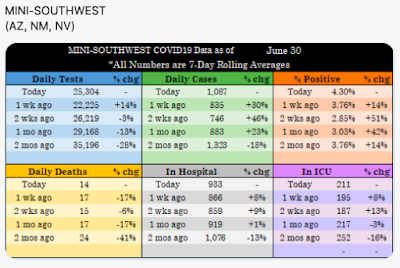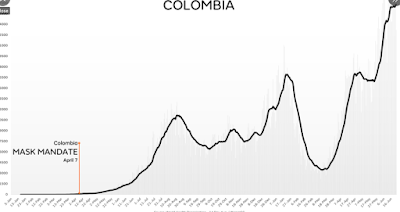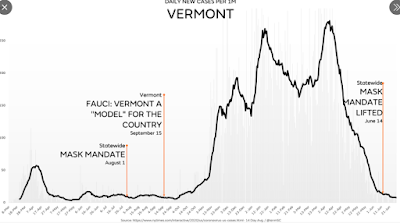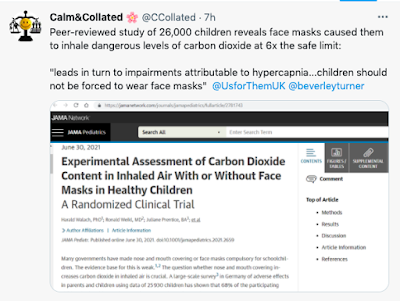Special Note: BeeLine is using a new service for email subscribers. All current email subscribers should have been automatically converted to the new service. If you did not get an email with today's content from the new system you should re-subscribe by going to the BeeLine website
The email from new service should have the BeeLine header at the top of the blog content.
If you don't see this you are viewing an email from old system that will soon be discontinued. Take action now to subscribe if for some reason your email address was not transferred over to the new system.
Todays' blog post follows below.
------------------------------------------------------------------------------------------
Where are we going with Covid?
What can we expect next?
The drop in confirmed cases in the United States is astounding.
The vaccines appear to have had an effect.
However, just how large an effect has it been?
Cases dropped by 73% between January 11, 2021 and February 20, 2021. They are now down 95% since that date.
By February 20, only 5% of the population in the United States was fully vaccinated. On January 11 no one was fully vaccinated.
The data alone suggest that this drop is not solely due to the vaccines. Most of the decrease had occurred before the vaccines really took hold.
There clearly has also been an effect from herd immunity from those who had existing antibodies and the fact that all viruses eventually burn out.
For example, the most recent CDC data of blood donors across the country found that an estimated 49% of the population had detectable antibodies in their blood as of the middle of March.
 |
| Source: https://twitter.com/kerpen/status/1409631082492874756/photo/1 |
Most of this would have been related to natural antibodies as only around 20% of the population at that time had taken one dose of the vaccine.
Seasonality has also had a huge impact on the transmission of Covid as it does with every respiratory virus.
These viruses spike in the fall and winter and decline in the spring and summer.
You can see this graphically in the CDC's surveillance data that tracks outpatients visits to health care facilities each flu season.
The spike in cases usually begins around Week 46 (middle of November), peaks sometime between January and March, and is back to a stable level by the end of April.
The red triangles in the chart below are 2020/21 visits for flu-like illness.
 |
| Source: https://www.cdc.gov/flu/weekly/ |
Notice that the flu all but disappeared in the 2020-21 season. Some have attributed this to mask usage and social distancing. I tend to believe it was due to viral interference. Simply stated, Covid overwhelmed any other pathogen that was trying to gain a foothold in attacking people's immune system.
One of the more incredible stats I saw this year was this fact reported by NPR that flu only resulted in 165 patients being hospitalized through February 15 in the current flu season that began in October. The similar number for last year---400,000!
 |
| Source: https://www.npr.org/2021/02/14/967431377/where-did-the-flu-go-homebound-kids-shape-a-mild-season?utm_campaign=npr&utm_medium=social&utm_term=nprnews&utm_source=twitter.com |
It is also interesting to note that there were 378,259 patients admitted to the hospital with Covid between October, 2020 and April, 2021 (2020/21 flu season) per CDC data.. In effect, no more people ended up in the hospital with Covid than did for the flu last year.
Have you ever heard this?
Although Covid cases have shown a large decline nationally since January I am interested to see what occurs across the Sunbelt in July and August.
We saw cases explode in this area last year after New York, New Jersey and other hot spots saw their cases decline in the summer.
I believe that the cases went up as more people in these hot areas sought the refuge of air conditioning indoors and avoided the sun and outdoors.
The more I research and study the Covid issue the more it appears to me that locking down and not being out and about actually makes you more vulnerable to the virus.
For example. which groups had the most widespread transmission of Covid last year?
Nursing homes and prisons. The populations in these facilities are generally in a lockdown mode to begin with. They are not out in the general population and are not having their immune system challenged every day by being exposed to all of the stuff that is circulating in the community. The challenges to your immune system is what makes it stronger and more resilient when attacked by a foreign pathogen or germ.
Where else did we see widespread breakouts?
Meat packing plants. These are cooled facilities that also have systems to limit microbes and bacteria in the processing of the meat. This would generally mean a more sterile environment than what most other people confront in their daily lives.
Recall a few other observations I made over the last 18 months that fit the pattern.
1) There were more Covid cases in New York among those who never left their houses than those who worked in essential services such as grocery stores and public transportation. I wrote this at the peak of the pandemic in New York last year.
Based on a recent survey of those hospitalized in New York over a 3-day period of 1,200 patients at 113 hospitals, the state found that the overwhelming number of those who recently were hospitalized with the virus were retired or unemployed and were sheltering in place and leaving their home only to shop for essentials.
In total, 83% of the new cases were of those retired or unemployed.
The survey also found that almost no one hospitalized with the virus had been working in an essential service. There were very few hospital, transit, grocery or drug store employees.
Only 17% of the new cases that were investigated were of those employed.
2) American Airlines reported fewer cases in employees involved in flight operations (flight attendants, pilots etc.) than those who were not dealing with the public and traveling.
3) Indiana University reported that there was a direct correlation between the numbers of credit hours a student took virtually with the odds of getting Covid. In other words, students who took all of their classes in person had the lowest incidence of Covid. Those who took all of their classes online had the highest incidence
To further support this point, I recently met someone at a party who had worked at Kroger in many high level positions over the years but recently retired. I asked if he knew how many Kroger store employees had contracted Covid since they were on the frontlines during the entire pandemic. He stated he did not know the exact percentage but he did know that the percent of cases was less than the general population.
Do you see a possible pattern?
I will be surprised if we don't see an increase in cases in the Sunbelt over the next two months due to the seasonality effect.
In fact, recent data suggests that we are beginning to see an uptick in cases.
Cases are up in AZ, NM and NV in the last week as is the positivity rate from tests.
They are up slightly in Texas although positivity rate continues to decline.
Florida is no longer updating its Covid numbers daily but it showed a slight increase in cases. Positivity was also up slightly.
 |
| Source: http://ww11.doh.state.fl.us/comm/_partners/covid19_report_archive/covid19-data/covid19_data_latest.pdf |
How the Sunbelt withstands the next two months could tell us a lot about where we are going with Covid in the Fall in the rest of the country.
I will also not be surprised if we see a surge in colds, flu and RSV in the coming months as so many people have not been exposed to germs and pathogens over the last year that they normally would. They will be more vulnerable than they have been previously. This will probably be a bigger problem than Covid when schools open in the Fall.
Many are still arguing that masks are essential in combating the spread of Covid. I know that it is a natural human impulse to believe that doing something is better than doing nothing. However, the data I see does not support that masks do much to inhibit transmission.
For example, here is a chart showing the experience of Austria which included a requirement that everyone wear a medical grade mask beginning January 25.
 |
| Source: https://twitter.com/ianmSC/status/1409252635262132224/photo/1 |
Here is another chart showing Covid cases in Columbia.
Here is one from Vermont which Dr. Fauci called a "model" for the country last September before cases went up 3,914%.
I understand why people want to believe that masks work. We want to be in control. We don't want to be defenseless. Early in the pandemic I was wondering why masks were not being recommended as having traveled in Asia I saw them often on the streets. Early in the pandemic (outside of China) Asia was largely spared.
I wondered why masks were not being recommended. I prepared to do a blog post on the topic. I then did the research and could not find one study that indicated that anything other than a properly fitted N95 mask offered any real protection.
The good news is that where I live it is now rare to see anyone wearing a mask. I was at Costco today and no more than 5% were wearing masks. It was almost 100% in any store a month ago. It was probably 50% two weeks ago. It is another telling example of herd mentality. The person without a mask felt ostracized a month ago. It is now the other way around.
For those who think that children should be wearing masks in school either because of Covid or due to my concerns about an increase in colds, flu, etc in the Fall, I would refer you to this new RCT study that was just published in the JAMA.
It turns our that we may actually be doing children more harm than good by forcing them to wear face masks.
The Covid narrative is now pushing the so-called Delta variant that supposedly came out of India. It is being used to promote more fear and to push more young people to be vaccinated.
The Delta variant is very likely more transmissible than other variants. However, I see no evidence that it is more serious than previous variants. In fact, the history of virology shows that as a virus mutates it becomes less lethal over time.
This seems to be borne out with what we are seeing in the UK right now. Cases are up but deaths are not following that trend.
 |
| Source: https://twitter.com/OBusybody/status/1410661297633497088/photo/1 |
That chart also cannot provide comfort that the vaccines (most specifically the Astra Zeneca vaccine that has been used most widely in UK) are doing a real good job of preventing transmission in the UK. A higher percentage have been vaccinated in the UK than in the USA.
In fact, cases in Scotland are now higher than they have ever been since the pandemic began!
At the same time, Scotland (like the UK generally) has vaccinated a higher percent of the population than the U.S.
The good news is that hospitalizations have not increased much.
Meanwhile, cases have plummeted in India over the last 6 weeks. Two months ago we were being told there was no hope for India.
Cases have collapsed despite the fact that only 4% of the population in India has been fully vaccinated. That compares to 46% in the United States.
Cases per million have fallen 87% since their peak on May 8.
This success clearly had little to do with the vaccines.
Is it natural population immunity taking hold?
Could it be due to Ivermectin, the drug that has been consistently maligned by Dr. Fauci and other leading U.S. public health experts?
I don't know but I do know that a number of large Indian states embarked on a public health program of distributing Ivermectin to every citizen beginning in mid-May. This was done as a preventative measure.
 |
| Source: India Today, May 12, 2021 |
The states of Goa and Karnataka did the same.
Causative or coincidence?
We may find out at some point. However, the only reason the vaccines were approved for emergency use authorization was the fact that there were supposedly no other "adequate, approved and available alternatives".
Is that really true?
There is no disputing the fact that the death rate among those age 65 and older have dropped significantly since the vaccines have been introduced.
These are the age groups in which the vaccination rate ranges from 89.9% for those age 65-74 to 86.0% for those age 75+.
We would all like to think the vaccines are responsible.
All the mortality data below is from USMortality.com. Predicted deaths are based on CDC data projections.
Death rates for ages 65-74 from January, 2020 forward.
 |
| Source:https://www.usmortality.com/ |
Death rates for ages 75-84.
 |
| Source: https://www.usmortality.com/ |
Death rates for ages 85+.
 |
| Source: https://www.usmortality.com/ |
Deaths for those age 75 and older are now below the long-term averages.
This appears to be proof of the success of the vaccines for the most vulnerable.
However, could it be that some of the deaths we experienced in December and January were merely pulled forward by a few months?
The same argument might be made at the beginning of the chart. Deaths among these age groups were running below average right before Covid hit. Were some of the people who died living on borrowed time?
This is why I think it is difficult to make definitive statements about much of what is going on with Covid.
More troubling is looking at the death statistics for younger ages.
While deaths are declining for the old, excess deaths are rising for those 44 and younger.
These are not Covid deaths. Something else is driving these.
Mental health? Drugs? Adverse effects of the vaccine?
What is it? Why is there not much attention being directed to it?
Overall deaths for those ages 0-24 generally were generally within long-term averages since January, 2020. Since April they appear to be trending up. These numbers are not final but it is disturbing nonetheless.
The age 24-44 age group has seen a consistent pattern of excess deaths since March, 2020. It has never come down. In fact, it appears to be accelerating in the last two months with the CDC's preliminary data. Again, these are not Covid deaths. What is causing this?
Where are we going with Covid?
I wish I knew.
As referenced above, there is still much that we really don't know about why and what has already happened with Covid.
Did lockdowns save lives or cost lives?
Are masks just a device to make people feel that they have a sense of control?
Are Ivermectin and other drugs that were already in use, and available, effective therapeutics against Covid?
Are the vaccines as effective and safe as advertised and promoted for all ages or is there a point at which the risk outweighs the benefit?
I don't know the answers to these questions. I just look at the data and try to make sense of it. And the data raises a lot of questions in my mind. The experts are trying to convince us they have all the answers. It seems they should spend more time pondering the questions than telling us they have all the answers.
Let's all hope that where we are going with Covid we will get better answers to these questions.
















No comments:
Post a Comment